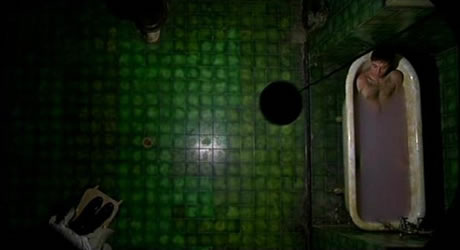Far higher authorities than I have praised Dark City. When Roger Ebert himself deigns to record a rare audio commentary on your movie — an honor shared with films like Casablanca and Citizen Kane — you can bet that your film will be thought of in unique and positive terms when remembered.
Dark City, a deliriously dreamlike sci-fi noir from 1998, directed by Alex Proyas, had the serious potential to fall into the trap of slavish imitation. Neo-noirs are generally quite unlikely to be at all unique, and Dark City does not hide its influences and models (classic noirs, certainly, but 1982’s Blade Runner most of all). Nevertheless, Proyas and company were able to craft a film of devilish appeal, an engrossing mystery thriller boasting one of the all-time great production designs.
Rufus Sewell’s protagonist wakes up in a strange hotel room with green walls, immersed in a bathtub full of purple-tinted water, with no memory of who he is, or was. Like the viewer, Sewell’s character is thrown headfirst into the story of Dark City with little-to-no understanding of what the hell it’s supposed to be about.* Proyas uses a neat bag of visual tricks to immerse the viewer while giving clues that things ain’t quite right. The use of colors like purple and green, naturally “off” colors, provokes a kind of slight nausea in the viewer.
*Except that is, in the studio re-cut, which begins with an overly-expository voiceover. The version of the film reviewed here is the Director’s Cut later released on DVD.
Following this first scene, we see the “dark city” itself — the bleak, sterile, claustrophobic, and really, really fucking dark city. And boy, is it a treat. The production design on the film is quite simply stunning, and this whole metropolis — a pseudo-1940s city of seedy motels, subterranean jazz clubs, and looming billboards — has an unmistakably tangible feel. Every concrete cinder-block seems to have a real weight and tactility to it. When Sewell’s character, “John Murdoch,” walks under an elevated train platform, we really feel as though he is standing under a train platform, even though we should know that the whole thing is a set cooked up somewhere in Australia.
The Dark City has no sunlight whatsoever, and the buildings all seem to tilt towards the streets, blanketing the characters in a perpetual veil of shadows. This is broken up only by the sickly greens and yellow glows of the neon signs and streetlights. Proyas, and cinematographer Dariusz Wolski, understand that in a movie dominated by darkness, the audience needs those sickly and unsettling colors to keep visual stimulation; save the greys for bland office parks, but be sure to add color to your nightmares.
The plot of Dark City is a bit hard to summarize, and, quite frankly, it is not quite as interesting as the stylistic elements that Proyas indulges in. Sewell’s John Murdoch slowly attempts to piece together his identity and his past while being chased by the “Strangers,” a group of mysterious hairless beings in black trenchcoats. The “Strangers” look like Max Schreck’s Count Orlock by way of Dick Tracy, and their ongoing presence provides a nicely horrific element to the proceedings. Also pursuing Murdoch is a hardboiled policeman, played by William Hurt — frequently shot from low angles, emphasizing the unusually fascinating bony structure of his head — and Murdoch’s estranged wife, played by Jennifer Connelly. Seeming to hold the key to so many secrets is Kiefer Sutherland’s character, a crippled neurosurgeon familiar to and intimate with the Strangers.
I won’t give away the rest of the plot, but I will say that the film’s climax disappoints, reducing what could be a truly engrossing psychological and philosophical struggle into a sort of Dragonball Z remake with Rufus Sewell and Ian Richardson. Which is not quite as entertaining as it might sound, unfortunately. In any case, the “where” of where Dark City goes is less interesting than how it gets there. Proyas does not settle for being a one-trick pony in this film; if one tires of the darkness and claustrophobia (which manages to out-Gotham Anton Furst’s Gotham City of the beloved 1989 Batman movie), then the director throws one for a loop by inserting overexposed shots of brightness that seem to come from another film entirely. After such long stretches of darkness, the harsh light of day seems unreal, unbelievable, and even manages to hurt your eyes. Which it should, in this case. In Dark City, as in so many wonderful movies, it is okay to hurt. In fact, it’s often the way you’ll have the most fun.


